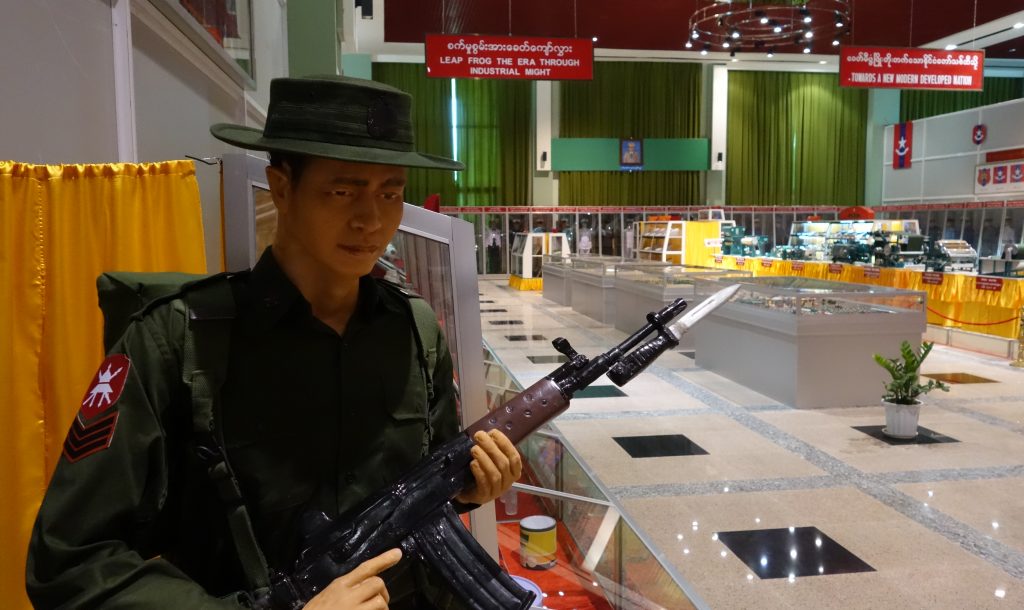This column was published by The Myanmar Times on Monday, 5 October 2015
Many years ago, on my first visit to Yangon, I went out to the old Defence Services Museum.
Inside the compound there were no other sightseers. Puddles on the floor and a lack of electricity made a miserable, dilapidated impression.
Whatever the strength of Myanmar’s uniformed rulers – at that time ascendant in almost every way – it was apparent that their museum needed some TLC. As a monument to Tatmadaw power it left a lot to be desired.
Eventually that decrepit compound was abandoned, following the long march of decision-makers and bureaucrats up the highway to Nay Pyi Taw.
The new Defence Services Museum in the military’s custom-built capital is something else entirely. Erected on a mind-boggling scale at the northern edge of the city, and opened in March 2012, it has lights, bilingual explanations and a big budget on its side.
The museum is the only place where ordinary people, Myanmar and foreigner alike, can get up close with the stories that Myanmar’s military authorities want us to know.
It still surprises me that so few people seem to take up this opportunity. Glancing at the list of foreign visitors it is clear that most who make the trek out to the museum are on some sort of official business. Defence attachés, and the like, are a key demographic.
It does not help that the museum was built in a lonely corner of the vast city, nestled alongside one of the stadiums bolted together for the 2013 Southeast Asian Games. Compared to the adjacent National Landmark Garden, or some of the city’s temples, markets or parks, the Tatmadaw showcase fails to get much public attention.
This is unfortunate because it is the closest that most people will ever get to the straight-shooting perspective of the military brass.
At the museum we see their worldview, all refracted through the work of strategy boffins, historians and spin-doctors. It is an unusual chance to digest their version of how they made modern Myanmar.
In every township around the country even a casual observer can see the legacies of military rule. Tens of millions of lives were given shape by the dictates of two generations of senior commanders, starting with General Ne Win and flowing all the way through to Senior General Than Shwe.
It was U Than Shwe’s final batch of military leaders who endorsed the 2008 constitution, stage-managed the 2010 national vote and then released Daw Aung San Suu Kyi from house arrest. The most famous of their number, President U Thein Sein and Pyidaungsu Hluttaw Speaker Thura U Shwe Mann, remain active political players.
All their ambitions will obviously get a big test with the November election. The current generation of military officers has no experience of surrendering authority at the ballot box, and was long trained to distrust democratic and ethnic voices.
Yet, for our benefit, their museum in Nay Pyi Taw has plenty of exhibits that explain the nationalist ideology of the armed forces and their self-perceived centrality to Myanmar society.
The presentation comes with an inevitable tilt, but also hopes to shed much light on what is otherwise an almost impenetrable institution.
Where else can you see a collection of Former Vice Senior General Maung Aye’s trophies and other keepsakes? Or get the blow-by-blow accounts of most of the 20th century’s major battles? Or come to appreciate the stop-start progress of dozens of different peace processes?
So why do so few people ever bother to visit the museum? Of course older Myanmar citizens can be excused: They did, when all is said and done, survive decades of Tatmadaw control. But youngsters have little excuse as the State Peace and Development Council years are quickly fading from view.
Even many of today’s university students seem hazy on what the pre-2011 era was really like. For those who do take the time to get re-educated in the military’s own story, a museum visit should not be taken as an endorsement of the old dictatorship.
Indeed, it could prove an effective way for more people to better appreciate the overwhelmingly destructive tendencies of military involvement in politics.
On the eve of the election, the time is right to be asking harder questions about those decades when Myanmar’s people did not have a chance to openly debate the role of the armed forces in society.
This history remains important precisely because the army will not evaporate when November’s votes are counted. On current trends, Senior General Min Aung Hlaing and his subordinates will exert real influence over the next government. That means the military’s own understanding of politics, change and power will need further scrutiny.
Given how hard it was in earlier years to find out even basic information about the armed forces, it is prudent to take full advantage of what is now being presented so publicly. The military’s Nay Pyi Taw museum has done us all a favour by putting so much of their story on show.
Nicholas Farrelly is director of the Myanmar Research Centre at the Australian National University and co-founder of New Mandala.
 Facebook
Facebook  Twitter
Twitter  Soundcloud
Soundcloud  Youtube
Youtube  Rss
Rss 